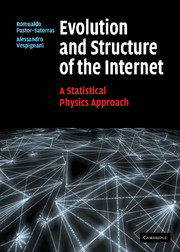Book contents
- Frontmatter
- Contents
- Preface
- List of abbreviations
- 1 A brief history of the Internet
- 2 How the Internet works
- 3 Measuring the global Internet
- 4 The Internet's large-scale topology
- 5 Modeling the Internet
- 6 Internet robustness
- 7 Virtual and social networks in the Internet
- 8 Searching and walking on the Internet
- 9 Epidemics in the Internet
- 10 Beyond the Internet's skeleton: traffic and global performance
- 11 Outlook
- Appendix 1 Graph theory applied to topology analysis
- Appendix 2 Interface resolution and router topology
- Appendix 3 Numerical analysis of heavy tailed distributions
- Appendix 4 Degree correlations
- Appendix 5 Scale-free networks: scaling relations
- Appendix 6 The SIR model of virus propagation
- References
- Index
Preface
Published online by Cambridge University Press: 12 January 2010
- Frontmatter
- Contents
- Preface
- List of abbreviations
- 1 A brief history of the Internet
- 2 How the Internet works
- 3 Measuring the global Internet
- 4 The Internet's large-scale topology
- 5 Modeling the Internet
- 6 Internet robustness
- 7 Virtual and social networks in the Internet
- 8 Searching and walking on the Internet
- 9 Epidemics in the Internet
- 10 Beyond the Internet's skeleton: traffic and global performance
- 11 Outlook
- Appendix 1 Graph theory applied to topology analysis
- Appendix 2 Interface resolution and router topology
- Appendix 3 Numerical analysis of heavy tailed distributions
- Appendix 4 Degree correlations
- Appendix 5 Scale-free networks: scaling relations
- Appendix 6 The SIR model of virus propagation
- References
- Index
Summary
For the majority of people the word “Internet” means access to an e-mail account and the ability to mine data through any one of the most popular public web search engines. The Internet, however, is much more than that. In simple terms, it is a physical system that can be defined as a collection of independently administered computer networks, each one of them (providers, academic and governmental institutions, private companies, etc.) having its own administration, rules, and policies. There is no central authority overseeing the growth of this networks-of-networks, where new connection lines (links) and computers (nodes) are being added on a daily basis. Therefore, while conceived by human design, the Internet can be considered as a prominent example of a self-organized system that combines human associative capabilities and technical skills.
The exponential growth of this network has led many researchers to realize that a scientific understanding of the Internet is necessarily related to the mathematical and physical characterization of its structure. Drawing a map of the Internet's physical architecture is the natural starting point for this enterprise, and various research projects have been devoted to collecting data on Internet nodes and their physical connections. The result of this effort has been the construction of graph-like representations of large portions of the Internet. The statistical analysis of these maps has highlighted, to the surprise of many, a very complex and heterogeneous topology with statistical fluctuations extending over many scale lengths.
- Type
- Chapter
- Information
- Evolution and Structure of the InternetA Statistical Physics Approach, pp. ix - xiiPublisher: Cambridge University PressPrint publication year: 2004



